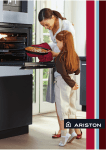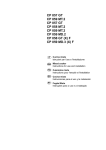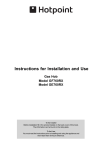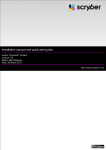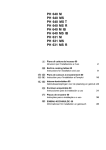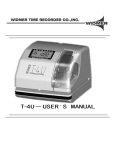Download Ariston CP 059 MTX UK Specifications
Transcript
CP 059 MT(X) UK Cooker maxioven Instructions for use end installation Congratualtions on choosing an ARISTON appliance, which you will find is dependable and easy to use. We recommend that you read this manual for best performance and to extend the life of your appliance. Thank you. SAFETY PRECAUTIONS THESE INSTRUCTIONS ARE ONLY VALID FOR THE COUNTRIES OF DESTINATION WHOSE SYMBOLS ARE SHOWN IN THE BOOKLET AND ON THE APPLIANCE RATING PLATE. 1. This appliance has been designed for private, nonprofessional use in normal dwellings. 9. Check that the capacity of the electrical system and the power outlets are suitable for the maximum power of the appliance, indicated on the rating plate. If in doubt, consult a professionally qualified technician. 2. Read the recommendations in this instruction booklet carefully, as they give important advice regarding safe installation, use and maintenance. Keep this booklet in a safe place for further reference when required. 10. Periodically check the condition of the gas connection pipe and have it replaced by a qualified technician as soon as it shows any signs of wear or anomaly. 3. Oven accessories which may come into contact with food are made of materials which comply with the contents of EEC Regulation 89/109 of 21.12.88 and national regulations in force. 11. Under no circumstances should the user replace the power supply cable or the gas connection pipe of this appliance. In the event of damage or the necessity for replacement, only contact an authorised service centre. 4. After having removed the packaging, check that the appliance is intact. If in doubt, do not use the appliance and contact professionally qualified personnel. 12. Do not leave the appliance plugged in if it is not in use. Switch off the main switch and gas supply when you are not using the cooker. 5. Some parts are covered with a removable scratch-proof film. Before using the appliance the film should be removed and the underlying part cleaned with a cloth and a non-abrasive household cleaning product. When switching on for the first time, it is advisable to heat the empty oven at maximum temperature for about 30 minutes to eliminate any residue from manufacture. 13. The burners and the cast-iron pan supports remain hot for a long time after use. Take care not to touch them. 14. To avoid accidental spillage do not use cookware with uneven or deformed bottoms on the burners. 15. Never use flammable liquids such as alcohol or gasoline, etc. near the appliance when it is in use. 6. All installation and adjustment operations should be carried out by qualified technicians in accordance with current regulations. Specific indications are given in the “instructions for the installer” paragraph. 16.If the cooker is placed on a pedestal, take the necessary precautions to prevent the same from sliding off the pedestal itself. 7. Before connecting the appliance, make sure that the data on the rating plate (situated on the rear part of the appliance and on the last page of the instruction booklet) correspond to those of the mains electricity and gas supplies. 17. To obtain the best results with the cooktop, several fundamental rules should be followed while cooking or preparing food. Use cookware with a flat bottom to make certain that the pot sets properly on the cooking area. 8. During operation, the oven glass door and adjacent parts of the appliance become hot. Make sure, therefore, that children do not touch the appliance. For greater safety, an additional child-safety device is available from our Head Office and our Authorised Service Centres (see enclosed list). When ordering this, please give the code: BAB - followed by the appliance model. The model is stamped on the plate which is visible on the front part of the oven upon opening the door. 1 COOKER DESCRIPTION F E A B C D E F Auxiliary gas burner Semi-rapid gas burner Rapid gas burner Triple ring gas burner Ignitor for Gas Burners Safety Device - Activates if the flame accidentally goes out (spills, drafts, etc.), interrupting the delivery of gas to the burner. G Grid pan H Electric oven selector knob (cooking function selection) M Control Knobs for Gas Burners N Electric oven thermostat knob (temperature selection) R Support Grid for Cookware S Electric oven operation indicator light T Timer 2 INSTRUCTIONS FOR USE When a liquid starts boiling, it is advisable to turn the flame down just enough to keep the liquid simmering. HOB OPERATION The hob is fitted with a pan reducing support (fig.1), which should only be used on the auxiliary burner "A" The burners are fitted with automatic ignition and a thermocouple safety device, which automatically cuts off the gas from the burner in a few seconds if the flame accidentally goes out during operation. The burners differ in size and power. Choose the most appropriate one for the diameter of the cookware being used. Each burner can be regulated with the corresonding control knob "M" by using one of the following settings: fig.1 MULTI-FUNCTION OVEN Off The oven offers nine combinations of heating elements; so the most suitable combination may therefore be chosen for each dish, with convincing results. High flame Low flame The symbols near the knobs show the position of the relative burner on the hob. By turning the selector knob “H” marked with the symbol , different cooking modes are obtained, as shown in To ignite a burner, proceed as follows: • turn the relative knob counter-clockwise until the pointer is on the high-flame symbol; • press the knob down fully and activate the automatic the following table: Symbol 0 ; gas ignition • keep the knob pressed down for about 10 seconds with the flame lit to allow the safety thermocouple to be heated; • release the knob, checking that the flame is stable. If it is not, repeat the operation. For minimum power, turn the knob towards the low flame symbol. Intermediate positions are possible by simply putting the knob anywhere between the high and the low flame symbol. To turn off the burner, turn the knob clockwise to the off position " ". Function Power 0) Off - 1) Top + Bottom heating elements 2350 W 2) Bottom heating element 1300 W 3) Top heating element 1050 W 4) Grill heating element 2000 W 5) Maxigrill (Top + Grill eating elements) 6) Maxigrill (Top + Grill heating elements) + fan Important: • Do not activate the automatic ignition device for more than 15 consecutive seconds. • Difficulty in ignition is sometimes due to air inside the gas duct. • If a burner flame accidentally goes out, the gas continues to exit for a few moments before the safety device activates. Turn the control knob to the off position and do not attempt ignition again for at least 1 minute, thereby letting the gas disperse, which could otherwise be a danger. • When the appliance is not in operation, check that the knobs are in the off position " ". The main gas supply cut-off cock should also be closed. 3050 W 3100 W 7) Bottom heating element + Fan 1350 W 8) Rear round heating element + Fan 2850 W 9) Fast defrosting 50 W After having selected the heat source, put the thermostat knob "N" (marked with the symbol ) onto the temperature required. Using the burners To obtain maximum efficiency from the burners, it is advisable to only use pans with a diameter suitable for the burner being used, so that the flame does not extend beyond the pan base (see following table). • For traditional cooking (roasts, biscuits, etc.) in Burner Diameter of the pan in cm. Auxiliary A from 6 to 14 Semi-rapid B from 15 to 20 conventional mode use the mode (hot above + below). Only put the food to be cooked into the oven when it has reached the selected temperature and preferably use just one shelf for cooking. To provide heat only to the bottom or the top part of the dishes, turn the selector to the position (hot below) R api d C from 21 to 30 or Triple ring D from 24 to 30 3 (hot below + fan) or (hot above); • With this Indicator light "S" (figure a on page 2) It indicates that the oven is heating up. When the light goes out, the required temperature has been reached inside the oven. When the light alternately comes on and goes out, it means that the thermostat is working properly to maintain the oven temperature. (fan assisted) mode heat is transmitted to the food through pre-heated air made to circulate inside the oven by a fan. The oven heats up very quickly so the food to be cooked may be put into the oven as soon as it is switched on. Cooking is also possible simultaneously on two shelves. • The “fast defrosting“ function uses no heating elements, just the oven light and the fan. • Grill operation: a high heat output is used for grilling, so that the surface of the food is immediately browned; this is particularly indicated for meats which should remain tender on the inside. To grill, turn the selector knob "H" to one of these positions: Spit - Rotisserie Insert the meat to be cooked along the length of the spit rod, securing it with the special adjustable forks (fig. 2a). Introduce the supports “A” and “B” (fig. 2b) into the holes in the drip tray “E”, rest the rod groove on the seat “C” and insert the oven rack into the lowest guide of the oven; now insert the spit rod into the relative hole, moving the groove forward into seat “D”. Start the rotisserie by turning the selector knob to one of the following positions: (grill), (maxigrill), (maxigrill + fan) During grilling, do not set the thermostat knob to above 200°C and keep the oven door closed. Oven light The oven light comes on automatically when the selector knob is turned to any of its positions. fig.2a fig.2b MAINTENANCE AND CLEANING Important: The appliance should be disconnected from the mains supply before starting cleaning operations. To ensure a long life cycle for the appliance, it is essential to carry out a thorough general clean frequently, while observing the following instructions: oven on at maximum temperature so that all grease residue and the like are eliminated. • If, after long-term use, you find evident grease stains deposited on the self-cleaning oven walls, probably due to your failing to follow the above maintenance advice, clean the surfaces thoroughly with hot water and a soft cloth (do not use any detergents), then rinse and dry thoroughly. Inside the oven door: Clean the surface with a cloth moistened with hot water and non abrasive liquid detergent, then rinse and dry thoroughly. • Do not remove any dry caked-on grease using sharp objects, as these could etch the self-cleaning coating. Inside the oven: • The inside of your oven is coated with a special selfcleaning microporous enamel glaze which, at a normal cooking temperature of between 200 and 300°C, oxidises and completely eliminates all grease spots or other substances that inevitably attack the inner walls of the oven. This way, cleaning is kept right down to a minimum: as a matter of fact, you just need to rub the surfaces of the oven with a wet cloth regularly, after cooking, to remove the thin layer of ash that may have been deposited during cooking, in order to maintain the selfcleaning property of the oven intact. • If the self-cleaning surfaces inside the oven are damaged or worn, due to incorrect or poor maintenance or after many years of use, you can request a kit of self-cleaning panels to line the inside of the oven. To order these, just contact an authorised Service Centre and quote the code AP 812. • After cooking where liquid has overflowed or when the dirt has not been eliminated completely (for example when grilling food, and the temperatures reached are not high enough for the full self-cleaning action of the enamel to be performed), we recommend you leave the 4 Removing/remounting the door The oven door is removable for easier access to oven for cleaning. Proceed as follows (fig.3-4): • • FIG. 3 • FIG. 4 Oven exterior: fully open the door; push the door downwards and simultaneously keep the levers “B” of the 2 hinges lightly pressed down, as shown in figure 3; with the 2 levers “B” always pressed down, start closing the door until the levers are released internally from the 2 arms “C”. Keeping the 2 lower arms “A” raised, now pull out the door as shown in figure 4. • Only clean the appliance when the oven is cold. To remount the door: • The steel parts and especially the areas with the screenprinted symbols should not be cleaned with solvents or abrasive detergents. It is advisable to use only a damp cloth with lukewarm water and washing up liquid. Stainless steel may remain stained if in long-term contact with very calcareous water or aggressive detergents (containing phosphorus). It is therefore always necessary to rinse and dry all surfaces thoroughly after cleaning. Important: cleaning operations must be made horizontally, in the direction of the steel glazing. • After cleaning, any treatments to polish the surfaces may be performed: only use specific products for stainless steel. • • • with the door in a vertical position, insert the 2 upper arms “B” into the upper slits, then lower the door and insert the 2 lower arms “A” into the lower slits. make sure that the housing “D” is perfectly connected with the edge of the slit (move the door slightly back and forth); push the door downwards as far as it will go, then close. Greasing the taps As time passes, a tap may lock or become difficult to turn. In this case it will be necessary to clean inside and replace the grease. This procedure must be performed by a technician authorized by the manufacturer. Changing the oven lightbulb Make sure that the appliance is disconnected from the electricity supply. Unscrew the glass protective cover from inside the oven, unscrew the lightbulb and replace it with an identical one suitable for high temperatures (300°C) and with the following characteristics: Voltage 230 V Wattage 15 W Type E 14. Important: do not use abrasive powders, aggressive detergents or acidic substances for cleaning. Hob: • The removable parts of the burners on the hob should be washed frequently with warm water and soap, making sure to remove any caked-on substances. Check that the gas outlet slits are not clogged. Dry the burners carefully before using them again. • Clean the end part of the automatic glow plug ignitors of the hob and gas oven frequently. 5 ELECTRONIC PROGRAMMER The electronic programmer has the function of automatically switching on the oven (at the required time) and switching it off at the end of the set cooking time. The 4 figure luminous display showing the actual time and the programming times, also shows the current state of the oven by means of the following symbols: A U T O Oven on Minute minder Automatic programme AUTO Point • (this divides the hour from the minutes on the display) All the functions may be programmed for a total of 23 h and 59 min. Maximum cooking time is 10 hours. Automatic oven mode (programmed cooking duration and end) • Put the food to be cooked in the oven. • Press the key (Duration) and adjust the cooking time using the and keys: the AUTO and (oven on) symbols light up (the oven switches on). • Press the key (end of cooking) and adjust the end of cooking time using the and keys: the symbol goes out (the oven switches off). • Turn the selector and the thermostat knobs onto the required function and temperature respectively. • The programmer automatically sets the start of cooking time, which is shown by the symbol (oven on) coming on. When the cooking time has elapsed, the oven is automatically switched off, the (oven on) symbol goes out and the AUTO symbol blinks; an acoustic signal sounds. Adjusting the clock (At installation, after power failures, clock in advance or behind). Select manual mode by pressing key , adjust the hour and minutes using the and . keys. Manual oven mode (Programming excluded) Press the key ; and the oven is switched on, the AUTO symbol goes out and the (oven on) symbol comes on. This operation erases any set programme. Semi-automatic oven mode 1st example: start in manual cooking mode - programmed cooking time. • Put the food to be cooked in the oven. • Press the key (duration) and adjust the cooking time using the and keys: the oven switches on, the AUTO and (oven on) symbols light up. • Turn the selector and the thermostat knobs onto the required function and temperature respectively. • At the end of the set cooking time, the oven is (oven on) automatically switched off, the symbol goes out and the AUTO symbol blinks; an acoustic signal sounds. 2nd example: start with manual cooking mode - end with programmed cooking mode. • Put the food to be cooked in the oven. • Press the key (end of cooking) and adjust the end of cooking time using the and keys: the oven switches on, the AUTO and symbols light up. • Turn the selector and the thermostat knobs onto the required function and temperature respectively. • At the end of cooking, the oven is automatically switched off, the symbol (oven on) goes out and the AUTO symbol blinks; an acoustic signal sounds. Minute minder Press the key (minute minder) and set the time required using the and keys. An acoustic signal sounds at the end of the programme. Buzzer The buzzer emits a sound for 7 minutes after the end of the selected programme; it may be stopped by pressing any function key. It is possible to choose 3 different types of acoustic signal. By pressing the key the actual signal tone appears. Now, within 7 seconds, every further press of the key changes the signal tone. Program control for the remaining time to be displayed, Press the key and the key to check the end of cooking time. Erasing programs Once a programme has been carried out, it is automatically erased; it can also be cancelled by pressing the key (manual). 6 COOKING TIPS Cooking times may change according to the nature of the foods, their homogeneity and their volume. When cooking a certain food for the first time, it is advisable to choose the lowest values in the cooking time range given in the table and then increase them if necessary. CONVENTIONAL OVEN COOKING Type of dish Temperature °C Cooking time (minutes) 130 130 150 160 160 170 170 200 200 200 200 60-70 30-40 20-30 40-50 40-50 30-40 40-50 15-20 15-20 15-20 15-20 Pastries and cakes Fruit pie Meringues S p o n g e ca ke A n g e l ca ke Madeira cake Chocolate cake F l a t sw e e t l o a f Puffs Flaky pastry biscuits Mille feuilles Shor t pastry Type of dish Temperature °C Cooking time (hours) Meat Turkey (4-8 kg.) Goose (4-5 kg.) Duck (2-4 kg.) Capon (2½-3 kg.) Braised beef (1-1½ kg.) Leg of lamb Roast hare (2 kg.) R o a st p h e a sa n t Chicken (1-1½ kg.) 160 160 170 170 160 160 160 160 170 3-4½ 4-4½ 1½-2½ 2-2½ 3-3½ 1-1½ 1-1½ 1-1½ 1-1½ Fish 200 15-25 minutes GRILLING Type of dish Cooking time (minutes) Position of shelf 60 15 60 60 60 3rd guide rail 2nd guide rail 1st guide rail - Chops (0.5 kg.) S a u sa g e s Grilled chicken (1 kg) Veal on the spit (0.6 kg.) Chicken on the spit (1 kg.) FAN ASSISTED COOKING Type of dish The 1st guide rail is understood as being the lowest position. Guide rail No. Quantity Temperature Time from bottom kg . °C (minutes) Pastries and cakes * With beaten mix, in mould * With beaten mix, without mould Shor t pastry, flan base Shor t pastry with wet filling Shor t pastry with dry filling * With natural leavened mix Small pastries and cakes 1-3 1-3-4 1-3-4 1-3 1-3-4 1-3 1-3-4 1 1 0.5 1.5 1 1 0.5 175 175 175 175 175 175 160 60 50 30 70 45 50 30 2 2 2 2 2 1 1 1 1 1-1.5 180 180 220 180 200 60 70 50 70 70 1-3 1-3 1-3 1-3 1-3 1-3 1 1 1 1-1.5 1.5 1-1.5 160 160 160 180 180 180 80 90 90 90 120 120 1 1 1 1 175 175 120 110 Fish Fillets, steaks, cod hake, sole Mackerel, turbot, salmon Oysters 1-3 1.3 1-3 1 1 180 180 180 30 45 20 Timbales Baked pasta dish Vegetable pudding * Sweet and savoury soufflés * Pizzas and savoury roll Toasted sandwiches 1-3 1-3 1-3 1-3-4 1-3-4 2 2 0.75 0.5 0.5 185 185 180 200 190 60 50 50 30 15 1-3 1-3 1-3 1-3 1 0.5 0.75 1 200 50 50 50 45 50 70 110 Meat Roasts under grill Veal B eef English roast beef Pork C h i cke n Roasts on tray Veal B eef Pork C h i cke n Turkey slices D u ck Casseroles Braised beef Braised veal Defrosting Ready-to-eat dishes Meat Meat Meat Notes: 1) 2) 3) 4) Cooking times do not include oven pre-heating, except for those marked with an asterisk The indication given in the table for the guide rails is the one that should preferably be used in the event of cooking on more than one level. The indicated times refer to cooking on one shelf only; for cooking on more than one level, increase the time by 5 ÷ 10 min. For roast beef, veal, pork and turkey, on the bone or rolled, increase the times by 20 min. 7 INSTALLATION min. 50 mm. min. 700 mm. fig.6 In a chimney stack or branched flue (exclusively for cooking appliances) OFFICINA Directly to the outside Kitchen ventilation The air flow into the room where the appliance is installed must equal the quantity of air that is required for regular combustion of the gas and for ventilating the same room. Air must be taken in naturally through permanent apertures made in the outside walls of the room or through single or branching collective ventilation ducts in compliance with current standards and regulations. The air must be taken directly from the outside, from an area far from sources of pollution. The ventilation aperture must have the following characteristics (fig.7A): • total free cross section of passage of at least 6 cm² for every kW of rated heating capacity of the appliance, with a minimum of 100 cm² (the heating capacity is indicated on the rating plate); • it must be made in such a way that the aperture, both on the inside and outside of the wall, cannot be obstructed; • it must be protected, e.g. with grates, wire mesh, etc. in such a way that the above-mentioned free section is not reduced; • it must be situated as near to floor level as possible. fig.5 The following instructions are provided for qualified installers so that they may accomplish installation, adjustment and technical maintenance operations correctly and in compliance with current regulations and standards. Important: the appliance should be disconnected from the mains electricity supply before any adjustment, maintenance, etc. is carried out. Maximum caution should be used should it be necessary to keep the appliance connected to the electricity supply. The cookers have the following technical specifications: Cat. II2H3 + Class 1(appliance installed indipendently) or Class 2 Sub-clas 1 (appliances installed between two cabinet) The dimensions of the appliance are given in the figure on page 2. For trouble-free operation of appliances installed in housing units, the minimum distances shown in fig.5 should be observed. Adjacent surfaces and the wall at the rear should also be able to withstand an overheating temperature of 65 °C. The feet are screw-adjustable and whenever necessary should be used to make sure the cooker stands level. Detail A Adjacent room Room to be ventilated A Positioning This appliance may only be installed and operated in permanently ventilated rooms in compliance with current standards. The following requirements must be observed: • The appliance must discharge combustion products into a special hood, which must be connected to a chimney, flue pipe or directly to the outside (fig.6). • If it is impossible to fit a hood, the use of an electric fan is permitted, either installed on a window or on an external wall, which must be switched on at the same time as the appliance. Examples of ventilation holes for comburant air Enlarging the ventilation slot between window and floor fig. 7A fig. 7B The air inflow may also be obtained from an adjoining room, provided the latter is not a bedroom or a room where there is a risk of fire, such as warehouses, garages, fuel stores, etc. and is ventilated in compliance with the current standards and regulations. Air from the adjoining room to the one to be ventilated may be made to pass freely through permanent apertures with a cross section at least equal to that indicated above. These apertures may also be obtained by increasing the gap between the door and the floor (fig.7B). 8 If an electric fan is used for extracting the combustion products, the ventilation aperture must be increased in relation to its maximum performance. The electric fan should have a sufficient capacity to guarantee an hourly exchange of air equal to 3 ÷ 5 times the volume of the kitchen. Prolonged, intensive use of the appliance may require extra ventilation, e.g. an open window or a more efficient ventilation system by increasing the extraction power of the electric fan if installed. Liquid petroleum gas descends towards the floor as it is heavier than air. Apertures in the outside walls in rooms containing LPG cylinders should therefore be at floor level, in order to allow any gas from leaks to be expelled. Do not store LPG cylinders (even when empty) in basements or rooms below ground level; it is advisable to keep only the cylinder in use in the room at any one time and connected far from heat sources which could raise its temperature to above 50 °C. Adaptation to a different type of gas If the hob is to be converted for use with a type of gas other than that for which it was set in the factory (indicated on the label to be found on the hob), the burner nozzles should be replaced as follows: • Remove the pan supports and the burners. • Unscrew the nozzles “A” (fig.9) using a 7 mm socket wrench and replace them with the ones which have a diameter suitable for the type of gas to be used, according to the table 1 "burners and nozzles specifications). • On completing the operation, replace the old rating label with the one showing the new type of gas; the sticker is available from our Service Centres. Gas supply connection • Check that the appliance is set for the type of gas available and then connect it to the mains gas piping or the gas cylinder in compliance with current regulations and standards. • This appliance is designed and set to work with the gas indicated on the label situated on the actual hob. If the gas supply is other than the type for which the appliance has been set, proceed with replacing the corresponding nozzles (provided), following instructions given in the paragraph “Adaptation to different types of gas”. • For trouble-free operation, suitable use of energy and longer life of the appliance, make sure that the supply pressure complies with the values indicated in the table 1 "burners and nozzles specifications, otherwise install a special pressure regulator on the supply pipe in compliance with current standards and regulations. • Connect in such a way that the appliance is subjected to no strain whatsoever. Either a rigid metal pipe with fittings in compliance with the standards in force must be used for connecting to the nipple union (threaded ½"G male fitting) situated at the rear of the appliance to the right (fig.8), or flexible steel pipe in compliance with the standards in force, which must not exceed 2000 mm in length. Should it be necessary to turn the fitting, the gasket (supplied with the appliance) must be replaced. Upon completion of installation, check the gas circuit, the internal connections and the taps for leaks using a soapy solution (never a flame). Also check that the connecting pipe cannot come into contact with moving parts which could damage or crush it. Make sure that the natural gas pipe is adequate for a sufficient supply to the appliance when all the burners are lit Important: A pressure regulator, in compliance with the standards in force, must be inserted when connecting to a liquid gas supply (in a cylinder). A fig.9 Adjusting the low flame · Put the tap to the low flame position; · Remove the tap knob and turn the adjusting screw, situated inside of the tap stem (fig.10), using a screwdriver (loosening the screw increases the height of the flame, tightening decreases it). note: the adjusting screw must be fully screwed down for liquid gas. · Having obtained the low flame setting required and with the burner lit, abruptly change the position of the knob several times from minimum to maximum and vice versa and check that the flame does not go out. fig.10 ELECTRICAL CONNECTION THE APPLIANCE MUST BE EARTHED The hobs are designed to work with alternating current at the supply voltage and frequency indicated on the rating plate (situated under the hob or at the end of the instruction booklet). Make sure that the local supply voltage corresponds to the voltage indicated on the rating plate. Connecting the supply cable to the mains electricity supply For models supplied without a plug, fit a standard plug, suitable for the load indicated on the rating plate, onto the cable and connect to a suitable socket. To connect directly to the mains supply, a double-pole switch with a contact separation of at least 3 mm suitable for the load and fig.8 9 As the colours of the wires in the mains lead may not correspond with the coloured markings identifying the terminals in your plug, proceed as follows: Connect the Green & Yellow wire to terminal marked “E” or complying with current standards and regulations, must be fitted between the appliance and the mains supply outlet. The yellow-green earth wire must not be interrupted by the switch. The supply cable must be in such a position that no part of it can reach a temperature of 50 °C above room temperature. For installation above a built-under oven, the hob and the oven must be connected separately to the electricity supply both for safety reasons and for easy removal of the oven if necessary. Do not use adapters or shunts as they could cause heating or burning. Before connecting to the power supply, make sure that: • the limiter valve and the domestic system can withstand the load from the appliance (see rating plate); • the supply system is efficiently earthed according to standards and laws in force; • the socket or double-pole switch are easily accessible when the appliance is installed. Important: the wires in the mains lead are coloured in accordance with the following code: Green & Yellow - Earth Blue - Neutral Brown - Live or coloured Green or Green & Yellow. Connect the Brown wire to the terminal marked “L” or coloured Red. Connect the Blue wire to the terminal marked “N” or coloured Black. FAILURE TO OBSERVE THE ACCIDENT-PREVENTION REGULATIONS RELIEVES THE MANUFACTURER OF ALL LIABILITY. Replacing the cable Use a rubber cable of the type H05VV-F with a suitable cross section 3 x 1,5 mm². The yellow-green earth wire must be 2-3 cm longer than the other wires. BURNERS AND NOZZLES SPECIFICATIONS Table 1 Liquid gas Burner Diameter (mm) Thermal power kW (H.s.*) By-pass 1/100 Injector 1/100 Natural gas Flow * g/h Injector 1/100 Flow* l/h Nomin. Reduc. (mm) (mm) G30 G31 (mm) G20 Rapid C 100 3.00 0.7 40 86 218 214 116 286 Semi-rapid B 75 1.65 0.4 30 64 120 118 96 157 Auxiliary A 55 1.00 0.3 27 50 73 71 71 95 Triple ring D 130 3.25 1.3 57 91 236 232 124 309 30 37 Supply pressure (mbar) This appliance conforms with the following European Economic Community directives: - 73/23/EEC of 19/02/73 (Low Voltage) and subsequent modifications; - 89/336/EEC of 03/05/89 (Electromagnetic Compatibility) and subsequent modifications; - 90/396/EEC of 29/06/90 (Gas) and subsequent modifications; - 93/68/EEC of 22/07/93 and subsequent modifications. * At 15°C and 1013 mbar-dry gas Propane G31 H.s. = 50,37 MJ/kg Butane G30 H.s. = 49,47 MJ/kg Methane G20 H.s. = 37,78 MJ/m3 10 20 Cooker maxioven "CP 059 M(X) UK" 10/01 - 195032243.00 Xerox Business Services - Docutech viale Aristide Merloni, 47 - 60044 Fabriano tel. 0732/6611 - telex 560196 - fax 0732/662954 www.Merloni.com













